Hdwk - Study guides, Class notes & Summaries
Looking for the best study guides, study notes and summaries about Hdwk? On this page you'll find 30 study documents about Hdwk.
All 30 results
Sort by
HDWK EXAM PACKAGE DEAL
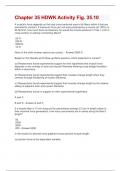
-
Chapter 35 HDWK Activity Fig. 35.10 Questions And Answers With Verified Tests
- Exam (elaborations) • 6 pages • 2024
- Available in package deal
-
- $7.99
- + learn more
A muscle's force depends on the total cross-sectional area of all fibers within it that are activated to contract. If maximum force per unit area produced by a muscle (at 100%) is 25 N/mm2, how much force (in Newtons, N) would the muscle produce if it has 1 cm2 in cross-section of actively contracting fibers? 25 N 250 N 2500 N 10 N None of the other answer options are correct. - Answer-2500 N Based on the Results and Follow-up Work sections, which statement is correct? (a) Researchers...
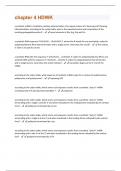
-
chapter 4 HDWK QUESTIONS WITH 100% PASSED ANSWERS
- Exam (elaborations) • 2 pages • 2024
- Available in package deal
-
- $7.99
- + learn more
a synthetic mRNA is created by random polymerization of an equal mixture of C bearing and G bearing ribonucleotides. according to the codon table, what is the expected amino acid composition of the resulting polypeptide product? - equal amounts of Ala, Arg, Gly and Pro a synthetic RNA sequence 5'UUUUUU....UUUUUCN 3', where the N stands for any nucleotide, codes for polyphenylalanine (Phe) that terminates with a single serine. what does this result? - the codons 5' UCN 3' all code for se...
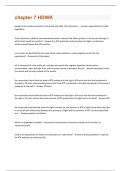
-
chapter 7 HDWK Questions And Answers With Verified Study Solutions
- Exam (elaborations) • 2 pages • 2024
- Available in package deal
-
- $7.99
- + learn more
based on the results presented in the graph and table, the researchers : - Answer-supported their initial hypothesis if the researchers added a transmembrane protein channel that allows protons to freely pass through it, what result would you predict? - Answer-less ATP would be produced when the light is on because protons would bypass the ATP synthase no controls are described for the experiment. what would be a useful negative control for the experiment? - Answer-all of the above pH is ...
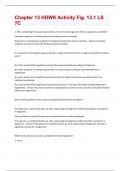
-
Chapter 13 HDWK Activity Fig. 13.1 LS 7C Questions And Answers Graded A+
- Exam (elaborations) • 2 pages • 2024
- Available in package deal
-
- $7.99
- + learn more
1. After completing the sequencing reactions, how is the entire genome from an organism assembled? Computer programs are used to automate finding sequence overlaps. Researchers manually piece together the fragments looking for areas of overlap. - Answer-Computer programs are used to automate finding sequence overlaps. If a researcher tried shotgun sequencing with a single chromosome from a single cell, would the process work? Yes, there would still be significant overlap after sequencing b...
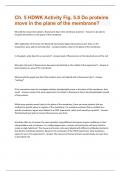
-
Chapter 34 HDWK Activity 34.9 Questions And Answers With Verified Study Solutions
- Exam (elaborations) • 2 pages • 2024
- Available in package deal
-
- $7.99
- + learn more
How long does an action potential last compared to one second? (a) 0.1 times as long (b) 10^-3 times as long (c) 1/100th times as long (d) the same time10 times as long - (b) 10^-3 times as long How might researchers experimentally test what ion leaves the axon, causing the axon to become repolarized after firing an action potential? (a) change the concentration of Cl- ions in the solution bathing the axon (b) create a short-circuit across the axon's membrane so that the membrane potenti...
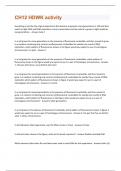
-
CH12 HDWK activity Questions And Answers Graded A+
- Exam (elaborations) • 1 pages • 2024
- Available in package deal
-
- $7.99
- + learn more
Everything is just like the original experiment (the bacteria is grownin many generations in 15N and then switch to light 14N) and DNA replication is semi-conservative and the culture is grown in light media for two generations. - Answer-tube C In a cell grown for many generations in the presence of fluorescent nucleotide, and then moved to grow in a medium containing only normal, nonfluorescent nucleotides for exactly one round of DNA replication, which pattern of fluorescence shown in the...
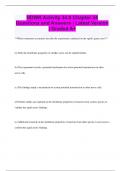
-
HDWK Activity 34.9 Chapter 34 Questions and Answers | Latest Version | Graded A+
- Exam (elaborations) • 8 pages • 2024
- Available in package deal
-
- $10.53
- + learn more
HDWK Activity 34.9 Chapter 34 Questions and Answers | Latest Version | Graded A+ **Which statements accurately describe the experiment conducted on the squid's giant axon?** (a) Only the membrane properties of smaller axons can be studied further. (b) The experiment reveals a potential mechanism for action potential transmission in other nerve cells. (c) The findings imply a mechanism for action potential transmission in other nerve cells. (d) Further studies are required ...
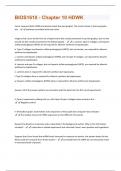
-
BIOS1610 - Chapter 10 HDWK Questions Perfectly Answered
- Exam (elaborations) • 2 pages • 2024
- Available in package deal
-
- $7.99
- + learn more
Caron measured both mRNA and protein levels (top two graphs). The results shown in the two graphs are: - positively correlated with each other. Imagine that Caron did the first set of experiments (the results presented in top two graphs), but not the second set (the results presented in the bottom graph). - a. Laminin, type IV collagen, and heparin sulfate proteoglycan (HSPG) are all required for albumin synthesis by hepatocytes. b. Type IV collagen and heparin sulfate proteoglycan (HSPG), ...
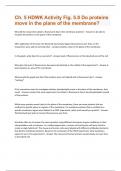
-
Ch. 5 HDWK Activity Fig. 5.8 Do proteins move in the plane of the membrane? Questions And Answers Graded A+
- Exam (elaborations) • 2 pages • 2024
- Available in package deal
-
- $7.99
- + learn more
Why did the researchers attach a fluorescent dye to the membrane proteins? - Answer-to be able to visualize the proteins in the plane of the membrane After application of the laser, the bleached spot slowly regains fluorescence over time, so the researchers were able to conclude that: - Answer-proteins move in the plane of the membrane. In the graph, what does the

$6.50 for your textbook summary multiplied by 100 fellow students... Do the math: that's a lot of money! Don't be a thief of your own wallet and start uploading yours now. Discover all about earning on Stuvia


